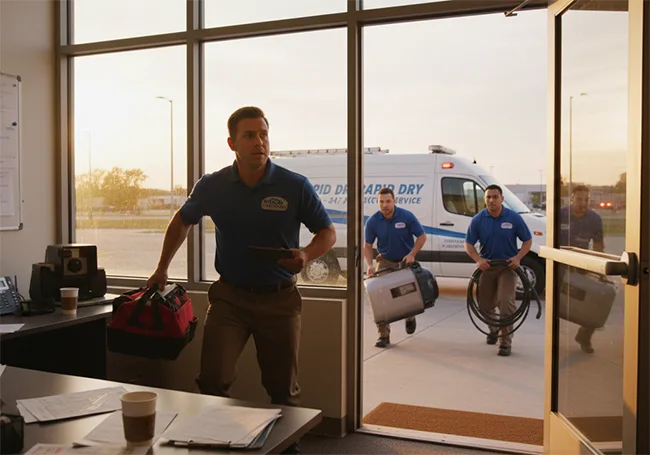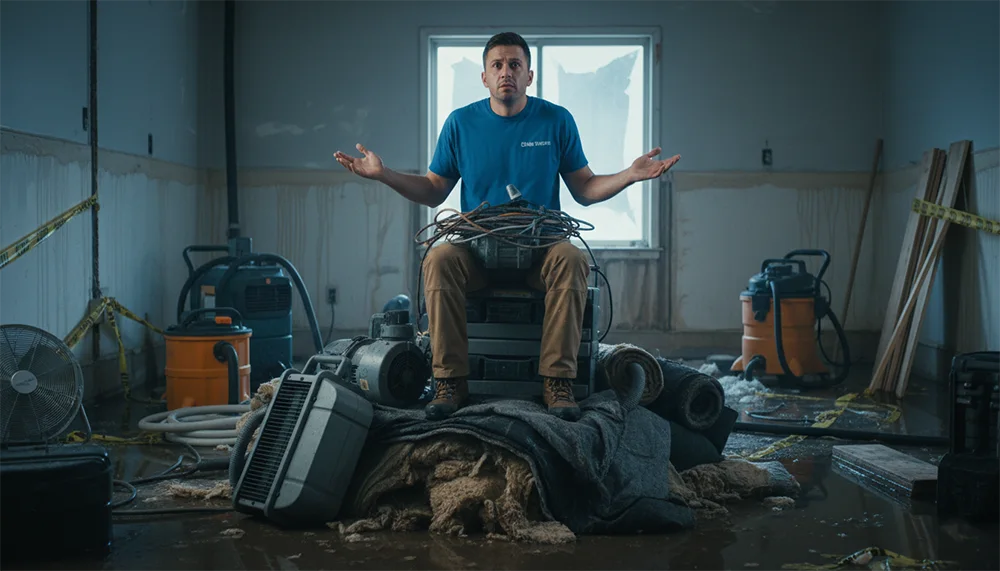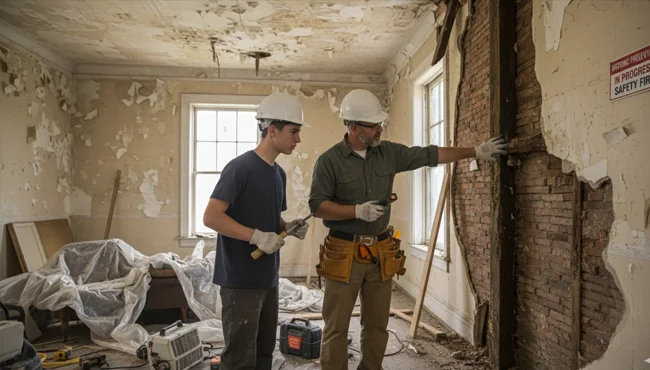If you’ve been in the restoration industry for a few years, you’ve probably noticed a pattern.
There’s a point—right around $1.5 million in annual revenue—where most businesses stall.
They’re no longer “small,” but they’re not truly scaling either.
They’ve got a few trucks on the road, a decent team, and a strong reputation in their market… yet growth slows to a crawl.
The phones still ring, but margins stay tight.
The owner still handles too much.
The systems don’t quite hold up as the jobs pile in.
And after years of grinding, they start wondering:
“What’s holding us back? Why can’t we break through to the next level?”
Here’s the truth most owners don’t realize—
The $1.5M plateau isn’t a sales problem.
It’s a trust system problem.
The Hidden Ceiling in Restoration Growth
From the outside, $1.5M looks like success.
But on the inside, many companies at this level share the same symptoms:
- Inconsistent lead flow (the “feast or famine” cycle)
- Cash flow crunches from slow insurance payments
- Team dependency on one or two key people
- Owner burnout because everything still runs through them
Sound familiar?
It’s not because you lack effort or technical skill—it’s because the business foundation wasn’t built to scale trust.
Trust is what converts website visitors into calls.
Trust is what keeps referral partners sending you work.
Trust is what allows you to build a team that can operate without you.
And most restoration companies simply haven’t systemized it.
That’s why Restoration Expertise developed the Restoration Success Blueprint—a framework that transforms “trust” from a buzzword into a measurable business asset.
The Restoration Trust Score: Your Growth Indicator
Every restoration company has a “trust score,” whether they track it or not.
It’s what determines how confidently homeowners choose you over a competitor, how much insurance adjusters cooperate, and how easily you attract top talent.
We call it your Restoration Trust Score—a metric that blends both perception and process.
It’s built around two core systems that drive every successful 7-figure restoration business: TACT and SVAC.
TACT: The Foundation of Professional Presence
TACT stands for Trust, Authority, Conversion, and Traffic—the foundational engine behind your brand’s credibility.
1. Trust
Trust starts with consistency.
Your Google profile, your website, your trucks, your uniforms—all tell the same story about professionalism and reliability.
Simple things like matching email signatures, before-and-after galleries, and on-site photography create subconscious confidence.
2. Authority
In restoration, authority comes from proof.
Certifications, Restoration Expertise badges, 5-star reviews, and community recognition signal that you’re a verified professional—not “just another contractor.”
Authority isn’t bragging. It’s showing.
3. Conversion
Once trust and authority are in place, your digital presence needs to convert.
That means your phone number is visible. Your calls-to-action are clear.
And your website is built like a digital employee—not a brochure.
If traffic comes in but doesn’t convert, you don’t have a marketing problem—you have a trust bottleneck.
4. Traffic
Only after trust, authority, and conversion are in place should you drive more traffic.
That’s where SEO, Google LSAs, and ads pay off—because now they’re feeding into a system that actually works.
SVAC: Scaling Trust into Systems and Visibility
Where TACT builds the foundation, SVAC (Structure, Visibility, Attraction, Conversion) scales it.
1. Structure
This is your internal trust system—the way your processes, tools, and people operate.
CRMs, review automation, standardized estimates, and clear job roles make trust repeatable.
When structure is weak, owners stay stuck in “babysitter mode.”
When it’s strong, the business grows predictably without chaos.
2. Visibility
Once your foundation is solid, amplify it.
Dominate local SEO, maintain your Google Business Profile, and make sure your name shows up in every relevant search and directory.
Restoration Expertise members with A+ or A++ badges naturally rank higher because those badges build algorithmic trust as well as human trust.
3. Attraction
Visibility brings awareness, but attraction converts it into interest.
That’s where storytelling, project photos, and authentic team culture come in.
People hire people they relate to—and authenticity sells more jobs than any ad campaign ever could.
4. Conversion
At this stage, conversion happens through automation and delegation.
Your systems—scripts, follow-ups, review requests—run without your direct involvement.
Trust is no longer just your personality; it’s your company’s identity.
The Three Real Reasons You’re Stuck at $1.5M
Let’s break down what your knowledge base calls “The 1.5M Trap.”
Every owner at this level hits at least one of these walls:
1. Lead Flow: The Feast or Famine Rollercoaster
You’re still relying on random calls or third-party programs for work.
One week you’re overloaded, the next week the phones are silent.
TACT fixes this by turning your website and reviews into consistent inbound leads—so growth is proactive, not reactive.
2. Cash Flow: The Paper Company Problem
Your invoices show you’re a million-dollar business, but your bank account doesn’t.
Restorers get paid last, slowly, and inconsistently.
SVAC helps by building systems for review follow-ups, documentation, and billing—so every claim gets paid faster and cleaner.
3. Talent: The Bottleneck Effect
You can’t scale if every decision still runs through you.
The solution isn’t just “hiring more people.” It’s building people who build the business.
When your team understands the company’s trust systems and sees a path for growth, they start acting like owners too.
Building a Trust System That Scales
Breaking through the $1.5M ceiling doesn’t happen through hustle—it happens through structure.
Here’s how to start building your Restoration Trust System:
Step 1: Audit Your Current Trust Score
Look at every touchpoint from the outside.
Would you hire your own company based solely on your website, reviews, and response time?
Be brutally honest.
Step 2: Strengthen Your Foundations (TACT)
Upgrade visuals, align branding, and showcase authority.
Your Restoration Expertise certification badge is your instant credibility marker—make sure it’s visible everywhere.
Step 3: Systemize Operations (SVAC)
Map every client journey step.
From the first call to the final review request, build repeatable processes that ensure no lead or invoice slips through the cracks.
Step 4: Automate Trust Loops
Use review automation, CRM reminders, and content scheduling to keep your reputation building even when you’re in the field.
Step 5: Empower Your Team
Train your staff on what the Restoration Trust Score means and how their actions affect it.
When everyone is invested in maintaining that standard, consistency skyrockets.
Step 6: Optimize Visibility
Leverage your digital assets—blog posts, project spotlights, and before/after stories—to show your expertise to homeowners before they ever need you.
Trust built early converts instantly during an emergency.
From Busy to Trusted Brand
Most restoration businesses stay busy.
Few become trusted brands.
The difference? Systems.
When you install trust systems like TACT and SVAC into your daily operations, you stop chasing the next job and start attracting ideal clients consistently.
Your brand becomes known for professionalism.
Your staff grows into leaders.
Your reviews multiply without begging for them.
And your business scales naturally—because trust compounds faster than ad spend ever will.
Final Thought
Every restoration owner has two options:
Keep pushing harder inside a broken system—or fix the system that drives the entire business.
The $1.5M plateau isn’t permanent.
It’s just the point where effort stops working and systems take over.
So ask yourself:
Where would your Restoration Trust Score stand if you measured it today?
That question alone might be the start of your next growth phase.





